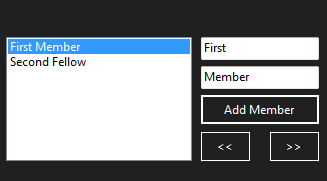As described in the comments, associating a BindingList (or a DataTable) with a BindingSource can have some interesting benefits.
All bound controls are updated automatically when one of the elements of the BindingList is modified or a new element is added to the list.
You can use the MovePrevious(), MoveNext(), MoveFirst(), MoveLast() methods to navigate the elements in the BindingList (other useful methods and events are available, see the Docs about the BindingSource functionality).
Here, a BindingList<T> (where T is the Member class shown below) is set as the DataSource of a BindingSource. Both are Fields of a Form class, this can be modified as needed.
The BindingSource is then used as the DataSource of a ListBox.
The Text property of two TextBox controls is then bound, using the BindingSource, to one of the properties of the Member class. This way, the Text property is set to the current Item of the BindingList. All controls are synchronized:
txtMemberName.DataBindings.Add(new Binding("Text", membersSource,
"FirstName", false, DataSourceUpdateMode.OnPropertyChanged));
txtMemberLastName.DataBindings.Add(new Binding("Text", membersSource,
"LastName", false, DataSourceUpdateMode.OnPropertyChanged));
This is how it works, in practice:

Note that the current Item of the ListBox is updated in real time when the Text of a TextBox is modified.
BindingList<Member> members = null;
BindingSource membersSource = null;
public partial class frmMembers : Form
{
public frmMembers() {
InitializeComponent();
InitializeDataBinding();
}
private void InitializeDataBinding()
{
members = new BindingList<Member>();
membersSource = new BindingSource(members, null);
lstBoxMembers.DataSource = membersSource;
txtMemberName.DataBindings.Add(new Binding("Text", membersSource,
"FirstName", false, DataSourceUpdateMode.OnPropertyChanged));
txtMemberLastName.DataBindings.Add(new Binding("Text", membersSource,
"LastName", false, DataSourceUpdateMode.OnPropertyChanged));
}
private void btnAddMember_Click(object sender, EventArgs e)
{
var frmNew = new frmNewMember();
if (frmNew.ShowDialog() == DialogResult.OK && frmNew.newMember != null) {
members.Add(frmNew.newMember);
}
}
private void btnMovePrevious_Click(object sender, EventArgs e)
{
if (membersSource.Position > 0) {
membersSource.MovePrevious();
}
else {
membersSource.MoveLast();
}
}
private void btnMoveNext_Click(object sender, EventArgs e)
{
if (membersSource.Position == membersSource.List.Count - 1) {
membersSource.MoveFirst();
}
else {
membersSource.MoveNext();
}
}
}
Sample New Member Form:
public partial class frmNewMember : Form
{
public Member newMember;
private void btnSave_Click(object sender, EventArgs e)
{
if (string.IsNullOrEmpty(txtMemberName.Text) ||
string.IsNullOrEmpty(txtMemberLastName.Text)) return;
newMember = new Member(txtMemberName.Text, txtMemberLastName.Text);
}
}
Sample Member class:
[Serializable()]
public class Member
{
public Member() { }
public Member(string firstName, string lastName)
{
this.FirstName = firstName;
this.LastName = lastName;
}
public string FirstName { get; set; }
public string LastName { get; set; }
public override string ToString() => $"{this.FirstName} {this.LastName}";
}
